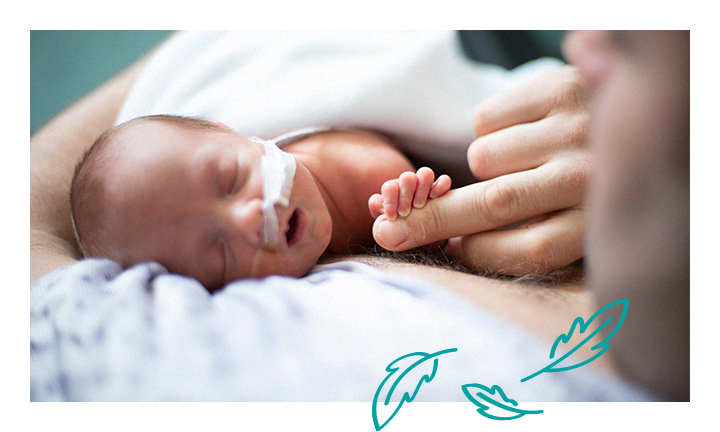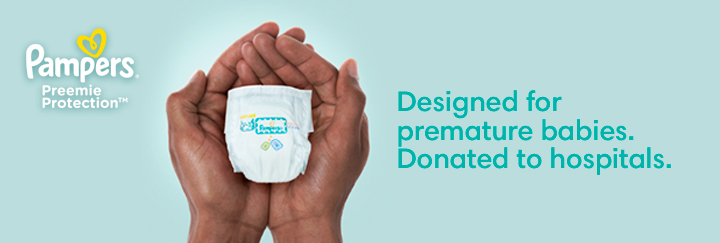
All About Premature Baby Skin
When babies born at full-term come into the world, their newborn skin may appear red and wrinkled due to their long stay in the moist and wet environment of the womb – taking days or even weeks for their skin to adapt to the outside world. A premature baby’s skin is even less mature and more delicate than a full-term baby’s skin. It needs to be handled with extra care. Read on to discover more about your premature babies’ skin, what it may look like, as well as how to care for it in the neonatal unit and at home.
Your Baby’s Delicate Skin
Like in adults, a baby’s skin is the first line of defence and is made up of several layers. This helps protect against infection by blocking things from the outside getting through the skin, while also functioning as an important insulator to keep us warm, and preventing water loss to keep the skin in good condition. In healthy, full-term newborns, their skin is still developing. For premature babies, this is even more important. Their skin has had less time to develop in the womb and is up to two times thinner than the skin of a full-term baby making it incredibly delicate and vulnerable to the world around them.
Depending on the prematurity of a baby, their skin is ‘leaky’ and takes several weeks to mature to that of a full-term baby, which is why it requires more attention and special care.
What Does a Preterm Baby’s Skin Look Like?
Your baby’s skin had less time to develop inside your warm, cosy womb, so it may look a little different to that of a full-term baby. Here’s how a preterm’s delicate skin may look:
Skin Conditions That May Affect A Baby Born Premature
As we mentioned above, a premature baby’s skin hasn’t had the chance to fully develop yet, making it thinner and more delicate than a full-term baby’s skin. This makes it more vulnerable. Here are some of the skin conditions that may affect a premature baby:
Jaundice
While jaundice isn’t actually a skin condition, it can make the skin and eyes appear yellow due to an excess of bilirubin, a yellowish substance made during your body's normal process of breaking down old red blood cells. It's not uncommon for newborns, especially those born prematurely, to develop jaundice. It’s typically mild and temporary and often resolved with treatment such as light therapy (phototherapy). Together with your neonatal team, you’ll discuss the appropriate treatment if your little one has jaundice.
Dry and Irritated Skin
At birth, all babies transition from the warm and wet environment in the womb to the dry, cooler temperature of the outside world. And this can be a bit of a transition for a baby’s skin. Dryness, peeling and irritated skin are common in preemies because it’s not fully mature yet and it may be a challenge to keep water in the skin, which is important for it to function. External irritants such as skin products, synthetic fibres in clothing and bedding may further irritate their sensitive skin.
Using appropriate skin care, avoiding products containing perfumes, and using soft and smooth materials for your little one’s bedding and clothing are a few ways to decrease irritation of their delicate skin. In this article, we will discuss this further in our section below: How to Care for Your Preemie’s Skin at Home.
Nappy Rash
Nappy rash is common in newborns, and because preemies have extra-sensitive and immature skin, they are more prone to it. When your baby does urinates or poos in their nappy, the enzymes in the pee and poo alter the skin’s pH, increasing the risk of irritation. Skin that is too wet or too dry is more susceptible to damage due to friction, so care should be taken when cleaning the skin. The increased skin wetness in and around the nappy area makes it particularly important to provide extra care to these areas. You may notice redness, scaly and dry patches, or spots and blisters on the bottom, upper thighs and genital area.
If your preemie has any of the above skin conditions, your neonatal care team – together with you as parents – will provide them with the appropriate care and treatment, as well as provide you with advice on how to care for their delicate skin.
A Preterm Baby’s Skincare in the Neonatal Unit
In the neonatal intensive care unit or NICU, the care staff will support you in caring for your preemie’s skin whilst in hospital and give you skincare advice if you’re preparing to take your baby home. Your neonatal care professionals will know when your little one is well enough to be handled and bathed. They will usually guide you through the process and support you to be involved in washing your preemie.
The Importance of Touch
Did you know touch is the first sense a baby develops in the womb? Touch (no matter how big or small) can have a soothing and comforting effect on your preemie as it releases the love hormone (oxytocin), which helps to form a close and loving relationship between you and your baby. So, creating those close and special moments through touch early on in the neonatal unit can benefit both of you. A baby’s sense of touch is also the most well-developed sense at birth. This means that keeping your little one’s skin comfortable and using gentle touch is very important. Your neonatal care team will show you the best ways to touch your baby according to their needs. It’s important to check your little one’s reactions to different forms of touch to see if they like it or not. Touch may include:
If you are able, skin-to-skin contact is encouraged and is a great way for parents to contribute to the growth and development of their baby.
How to Care for Your Preemie’s Skin at Home
Caring for your preemie at home can feel exciting but also overwhelming as you adapt to a new routine with your new arrival; however, the neonatal team will work together with you to help prepare you before you leave the neonatal unit. Here are some tips provided by neonatal healthcare professionals to help you care for your preemie’s skin and support you through these special moments.
Bathing and Drying
Here are some tips for bathing your premature baby at home for the first time and caring for their delicate skin:
Changing Nappies
Changing your baby’s nappy may be stressful and agitating for your baby. When changing your preemies nappy, remember to take things slow and calm to reassure them, and look out for any signs of discomfort. At any point you can stop and gently soothe your baby before starting again. Here’s your step-by-step guide for changing your preemies nappy, while keeping their skin comfortable:
Friends and families of babies born prematurely can now order their Pampers Preemie Protection Nappies online for free home delivery via www.pampers.co.uk. Pampers also continue to donate Pampers Preemie Protection nappies direct to hospitals, and via ASDA pharmacies (in-store only and subject to availability)
More Tips and Considerations to Make Your Baby’s Skin Comfortable
FAQS AT A GLANCE
A premature baby’s skin is up to two times thinner than a full-term baby’s skin. Their skin barrier is usually less developed, making it more delicate and vulnerable to infections and irritation. A preemie’s skin usually takes a few weeks to mature to the level of a full-term baby.
So, in that time, it’s important to provide it with special care, and follow the specialised advice of your neonatal care team. You can also get some helpful tips throughout our article.
The Bottom Line
Your baby has unique skin care needs due to their delicate and sensitive skin. Being aware of your baby’s needs are important and handling them gently during bathing, nappy changing, and bonding can provide them with the comfort and loving touch that they need. Whether at home or in the neonatal care unit, the staff will help you become as involved in your preemie’s care as possible and teach you best practices when handling your little one. As always, it is important to consult your neonatal care team if you need any support or have any concerns. With the right care and attention, you can help ensure that your baby's skin remains healthy and well-protected.
How We Wrote This Article The information in this article is based on the expert advice found in trusted medical and government sources, such as the National Health Service (NHS). You can find a full list of sources used for this article below. The content on this page should not replace professional medical advice. Always consult medical professionals for full diagnosis and treatment.
- Pampers Preemie Protection: Every Touch is Huge – Skin Fact Sheet. Hoeger PH, Enzmann CC. Skin physiology of the neonate and young infant: a prospective study of functional skin parameters during early infancy. Pediatr. Dermatol. 2002;19:256-62
- Post PW, Krauss AN, Walcman S, Auld PA. Skin reflectance of newborn infants from 25 to 44 weeks gestational age. Human biology. 1976;48:541–557.
- Burdal O et al. Neonatal skin care: Developments in care to maintain neonatal barrier function and prevention of diaper dermatitis. Pediatr Dermatol. 2019 Jan;36(1):31-35 Warren I. Family and Infant Neurodevelopmental Education. https://finetraininguk.com/ Accessed June 2022.
- Altimier, L et al. Neuroprotective Care of Extremely Preterm Infants in the First 72 Hours after Birth. Critical Care Nursing Clinics of North America. 2018. 30 (4): 563–583
- Jones, L., Laudiano-Dray, M. P., Whitehead, K., Meek, J., Fitzgerald, M., Fabrizi, L., & Pillai Riddell, R. (2021). The impact of parental contact upon cortical noxious-related activity in human neonates. European Journal of Pain (United Kingdom), 25(1).
- Warren, I et al. Caring for Your Baby in the Neonatal Unit : A Parents’ Handbook. Kibworth Beauchamp, Leicestershire, Matador. 2014.
- How to care for preemie baby skin: In the NICU and at home, by Claire Campbell Neonatal Care Coordinator, NHS Northern Neonatal Network
- Pampers Scientific Truths Visualisations
- Premature Babies Sense of Touch
- Pampers Keeping Baby Skin Comfortable Brochure
- Pampers Keeping Baby Skin Healthy Brochure
- Healthline. ‘Premature Baby Skin Problems.’
- NHS. ‘Breastfeeding Your Premature Baby.’
- NHS. ‘Getting to Know Your Baby Through Positive Touch and Interaction’.
- NHS: 111 Wales. ‘Getting to Know Your Newborn.’
- NHS. ‘Nappy Rash.’
- NHS: SGGC. ‘Premature Baby Sense of Touch.’
- NHS. ‘Special Care for ill or Premature Babies.’
- NHS. ‘Skincare for Neonates Guidelines.’
Read more about Prematurity
Related Articles
Join Pampers Club and get:













